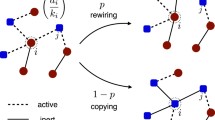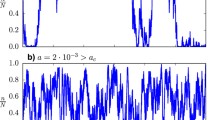Abstract
In nonlinear voter models the transitions between two states depend in a nonlinear manner on the frequencies of these states in the neighborhood. We investigate the role of these nonlinearities on the global outcome of the dynamics for a homogeneous network where each node is connected to m = 4 neighbors. The paper unfolds in two directions. We first develop a general stochastic framework for frequency dependent processes from which we derive the macroscopic dynamics for key variables, such as global frequencies and correlations. Explicit expressions for both the mean-field limit and the pair approximation are obtained. We then apply these equations to determine a phase diagram in the parameter space that distinguishes between different dynamic regimes. The pair approximation allows us to identify three regimes for nonlinear voter models: (i) complete invasion; (ii) random coexistence; and – most interestingly – (iii) correlated coexistence. These findings are contrasted with predictions from the mean-field phase diagram and are confirmed by extensive computer simulations of the microscopic dynamics.
Similar content being viewed by others
References
D. Abrams, S. Strogatz, Nature 424, 900 (2003)
P.S. Albin, The Analysis of Complex Socioeconomic Systems (Lexington Books, London, 1975)
J. Antonovics, P. Kareiva, Philos. Trans. R. Soc. London B 319, 601 (1988)
L. Behera, F. Schweitzer, Int. J. Mod. Phys. C 14, 1331 (2003)
E. Ben-Naim, L. Frachebourg, P.L. Krapivsky, Phys. Rev. E 53, 3078 (1996)
E. Ben-Naim, P. Krapivsky, S. Redner, Physica D: Nonlinear Phenomena 183, 190 (2003)
A.T. Bernardes, D. Stauffer, J. Kertesz, Eur. Phys. J. B 25, 123 (2002)
C. Castellano, S. Fortunato, V. Loreto, Rev. Mod. Phys. (2008) http://arxiv.org/abs/0710.3256
C. Castellano, V. Loreto, A. Barrat, F. Cecconi, D. Parisi, Phys. Rev. E 71, 066107 (2005)
C. Castellano, D. Vilone, A. Vespignani, Europhys. Lett. 63, 153 (2003)
X. Castello, V. Eguíluz, M. San Miguel, New J. Phys. 8, 308 (2006)
R.N. Costa Filho, M.P. Almeida, J.S. Andrade, J.E. Moreira, Phys. Rev. E 60, 1067 (1999)
J.T. Cox, D. Griffeath, Annals of Probability 14, 347 (1986)
L. Dall’Asta, C. Castellano, Europhys. Lett. 77, 60005 (2007)
M. De Oliveira, J. Mendes, M. Santos, J. Phys. A 26, 2317 (1993)
I. Dornic, H. Chaté, J. Chave, H. Hinrichsen, Phys. Rev. Lett. 87, 045701 (2001a)
J. Drouffe, C. Godrèche, J. Phys. A: Mathematical and General 32, 249 (1999)
R. Durrett, S. Levin, Theoretical Population Biology 46, 363 (1994)
L. Frachebourg, P. Krapivsky, Phys. Rev. E 53, R3009 (1996)
R.A. Holley, T.M. Liggett, Annals of Probability 3, 643 (1975)
J. Hołyst, K. Kacperski, F. Schweitzer, Physica A 285, 199 (2000)
T.H. Keitt, M.A. Lewis, R.D. Holt, The American Naturalist 157, 203 (2001)
B.E. Kendall, O.N. Bjørnstad, J. Bascompte, T.H. Keitt, W.F. Fagan, The American Naturalist 155, 628 (2000)
M. Kimura, G.H. Weiss, Genetics 49, 313 (1964)
P. Krapivsky, Phys. Rev. A 45, 1067 (1992)
P.L. Krapivsky, S. Redner, Phys. Rev. Lett. 90, 238701 (2003)
T.M. Liggett, Annals of Probability 22, 764 (1994)
T.M. Liggett, Stochastic Interacting Systems, Grundlehren der mathematischen Wissenschaften (Springer, Berlin, 1999), Vol. 342
J. Molofsky, R. Durrett, J. Dushoff, D. Griffeath, S. Levin, Theoretical Population Biology 55, 270 (1999)
C. Moore, J. Stat. Phys. 88, 795 (1997)
H. Mühlenbein, R. Höns, Advances in Complex Systems 5, 301 (2002)
M. Nakamaru, H. Matsuda, Y. Iwasa, J. Theor. Biology 184, 65 (1997)
C. Neuhauser, Theoretical Population Biology 56, 203 (1999)
A. Nowak, M. Kus, J. Urbaniak, T. Zarycki, Physica A 287, 613 (2000)
N.A. Oomes, D. Griffeath, C. Moore, New Constructions in cellular automata (Oxford Universitiy Press, 2002), pp. 207–230
S.W. Pacala, J.A. Silander, Jr., The American Naturalist 125, 385 (1985)
S. Redner, A guide to first-passage processes (Cambridge University Press, Cambridge, 2001)
F.J. Rohlf, G.D. Schnell, The American Naturalist 105, 295 (1971)
T. Schelling, Am. Econ. Rev. 59, 488 (1969)
F. Schweitzer, Brownian Agents and Active Particles. Collective Dynamics in the Natural and Social Sciences, Springer Series in Synergetics (Springer, Berlin, 2003)
F. Schweitzer, L. Behera, H. Mühlenbein, Advances in Complex Systems 5, 269 (2002)
F. Schweitzer, J. Hołyst, Eur. Phys. J. B 15, 723 (2000)
F. Slanina, H. Lavicka, Eur. Phys. J. B 35, 279 (2003)
V. Sood, S. Redner, Phys. Rev. Lett. 94, 178701 (2005)
H.-U. Stark, C.J. Tessone, F. Schweitzer, Phys. Rev. Lett. 101, 018701 (2008a)
H.-U. Stark, C.J. Tessone, F. Schweitzer, Advances in Complex Systems 11, 87 (2008b)
K. Suchecki, V.M. Eguíluz, M. San Miguel, Europhys. Lett. 69, 228 (2005a)
K. Suchecki, V.M. Eguíluz, M. San Miguel, Phys. Rev. E 72, 036132 (2005b)
G. Szabó, T. Antal, P. Szabó, M. Droz, Phys. Rev. E 62, 1095 (2000)
F. Vazquez, V.M. Eguiluz, M.S. Miguel, Phys. Rev. Lett. 100, 108702 (2008)
F. Vazquez, C. Lopez, Phys. Rev. E 78, 061127 (2008)
W. Weidlich, J. Mathematical Sociology 18, 267 (1994)
Author information
Authors and Affiliations
Corresponding author
Rights and permissions
About this article
Cite this article
Schweitzer, F., Behera, L. Nonlinear voter models: the transition from invasion to coexistence. Eur. Phys. J. B 67, 301–318 (2009). https://doi.org/10.1140/epjb/e2009-00001-3
Received:
Revised:
Published:
Issue Date:
DOI: https://doi.org/10.1140/epjb/e2009-00001-3




